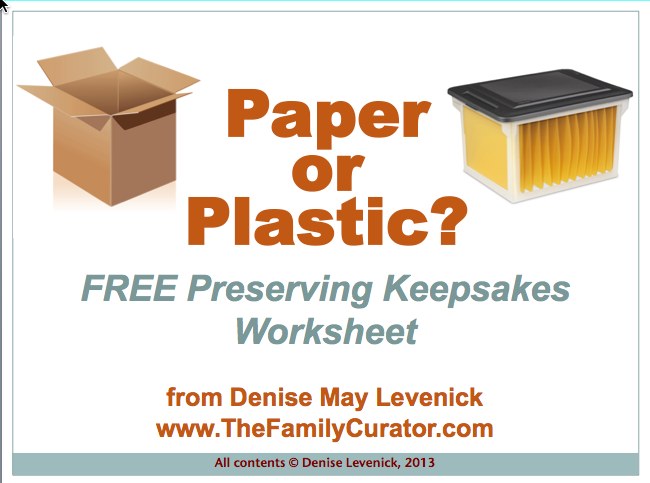When I first started working with the boxes of family photogaphs, old letters, and documents inherited from my maternal grandmother I was overwhelmed by the seemingly limitless selection of archival containers. I didn’t know if letters should be stored upright in file folders or flat in drop front boxes (answer: either). I was confused by plastic sleeves vs. paper sleeves for photo storage (answer: either). And, I really didn’t understand all the archival terms like acid-free, lignin, buffered, and P.A.T.

My presentation Paper or Plastic?: Preserving Keepsakes Workshop at last weekend’s Southern California Genealogical Society Jamboree in Burbank, California was designed to answer those questions. I wanted it to be the workshop I needed all those years ago. The 90-minute format gave time for a slide-show presentation followed by discussion of product options and lots of Q&A.
Use the Hands On Worksheet
To make it even more useful, I put together a Hands On Worksheet to walk through the first three steps of working with family collections. Answering these questions will help anyone wondering what do first when you inheirit family treasures. You may not have attended the Paper or Plastic Workshop, but I hope you will find this Worksheet useful for your own family archive.
Download the Preserving Keepsakes Workshop Worksheet HERE.
Here’s a brief overview of how to get started:
1. Decide on your role and goal.
Do you see yourself as a Curator, a Creator, or a Caretaker of the collection?
- A Curator arranges, selects, and finds meaning in a collection.
- A Creator might be more focused on how to refashion items (or information) into an artistic creation like a scrapbook or family tree.
- A Caretaker, is one of the most underrated roles, but we owe a debt to those Caretakers whose main goal is to preserve and pass on family keepsakes.
2. Name your collection.
Instead of “Grandma’s Stuff” start referring to your inheiratance as a collection, The Arline Kinsel Papers, The Brown Photo Collection, etc. You are preserving history, after all, the history of your family.
3. Decide where to locate your collection.
Find a place within your living space where the temperature is consistent, not too hot, not too cold, relatively dry and clean, and free of pests and pollution. It should also be fairly dark, as light hastens the deterioration of almost everything. An interior closet or even a metal filing cabinet are good choices.
Get Ready to Store Your Family Keepsakes
Next, you’ll need to make notes about the kinds and quantity of items you need to store and select appropriate containers. The Worksheet also includes:
- a form to get you started listing items, quantity, and container options
- photos of the most popular archival storage containers
- contact information for archival suppliers
You can download the FREE Workshop Worksheet Here and Get Started Archiving Your Family Keepsakes. Please let me know in the comments if you find it helpful!
… and now a word from our sponsors
Disclosure: The Preserving Keepsake Workshops featured popular archival products kindly supplied by Hollinger Metal Edge and Sentry Safe. I received samples from the company but no other renumeration. If you order from Hollinger and use FAMILYCURATOR in the Code Box, I receive a small referral commmisson. If you order supplies through Amazon using my links, I also receive a small affiliate commission.


